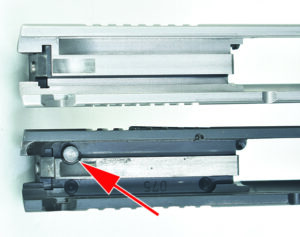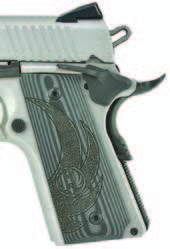Gun Tests Grade: B
$979
Well known (and justifiably so) for their 10/22s, single-action pistols, and 22 autos, as well as their centerfire rifles, Ruger got into the 1911 game a bit late — just about 100 years after Colt — but they have caught up in a big way. Not only did they take advantage of a century’s worth of engineering experience, they formed their own shooting team to wring their guns out in competition, a long practice in the shooting industry. Colt once sponsored Jerry Barnhart. S&W fields such top talent as Jerry Miculek and Julie Golob. SIG Sauer has the services of Max Michel and Lena Miculek. For their part, Ruger brought in such greats as Doug Koenig and Maggie Reese. Just like technology developed for space travel made it into our homes and parts engineered for NASCAR speedsters were eventually used in our personal cars, parts, tools, and techniques developed for shooting competition eventually wind up in our EDC guns.
| Action Type | Semi-auto, hammer fired |
| Overall Length | 7.25 in. |
| Overall Height | 5.1 in. |
| Maximum Width | 1.24 in. at thumb safety |
| Weight Unloaded | 1.9 lbs. |
| Weight Loaded (8 rounds 185 grain) | 2.4 lbs. |
| Slide Material | Stainless steel |
| Slide Retraction Effort | 19.6 lbs. |
| Receiver Material | Stainless steel |
| Finish | Glass bead |
| Front Strap Height | 2.4 in. |
| Back Strap Height | 2.8 in. |
| Barrel Length | 3.6 in. |
| Grip Thickness (Maximum) | 1.15 in. |
| Grip Circumference | 5.2 in. |
| Magazine | Two 7 round |
| Rear Sight | 2-dot Novak, drift adjustable |
| Front Sight | 1 dot in dovetail |
| Sight Radius | 5.3 in. |
| Trigger Pull Weight | 3.8 lbs. |
| Trigger Span | 2.9 in. |
| Safety | Manual thumb, grip, modified 70 Series-style firing pin |
| Warranty | None provided |
| Telephone | (336) 949-5200 |
| Website | Ruger.com |
| Made In | USA |
Just take a look at some of the parts on the Ruger SR1911 and compare them to parts Koenig designed years ago, and you can instantly see his influence. Ruger has developed/pioneered particular expertise in the areas of cast and MIM (metal injection molding) parts. Extensive use of these in the SR1911, with its cast frame to go along with many MIM internal parts, can bring you a good pistol produced using very modern manufacturing methods.

The Ruger SR1911 is also made of stainless steel, and they decided to leave this one with a more natural finish. And with the SR1911, the frame is also stainless steel — not aluminum. The metal has been bead-blasted. Edges have been nicely melted, leaving very few lines or points on which to cut a hand as the shooter manipulates the pistol. As with the Colt Defender, the nose of the slide has been beveled, giving a distinctive look to a pistol that should be easier to reholster. Diagonal grasping grooves are located at the rear of the slide only. The ejection port has been opened and tear-dropped.

The SR1911 uses a 70 Series firing pin set up instead of an 80 Series. Back in the day, there was concern that a 1911 could be dropped on the muzzle, causing the firing pin to move forward on impact. That could cause said firing pin to strike the primer, thereby firing the pistol. In the current litigious world, that would never do. There were a couple of solutions designed (one activated by the trigger and another by the grip safety), both of which would require something to be depressed before the firing pin could be released for forward travel. Colt adopted the trigger-activated system and incorporated that in the 80 Series update on their 1911s. It is a good system and works well — please note that it is also the system used on the Smith and SIG pistols in this test. It also adds a series of linkages and a plunger that must be depressed, all of which detract a bit from the potentially superb 1911 trigger. The parts obviously don’t ruin the process, but a little bit of additional take-up is required before the trigger is activated, and the shooter can feel that in the trigger. Leaving the trigger unrestrained was not an option, so an additional system was designed that uses a lightweight, frequently titanium, firing pin and an extra strength firing-pin spring. The combination prevents the firing pin from moving forward from the forces generated by a drop on the muzzle. Trigger compression feels like it should. Lawyers and shooters are happy. To repeat, Ruger uses the 70 Series system.

The 3.6-inch barrel on the Ruger is a solid cone shape that flares at the muzzle end. It is fully ramped and has a small slot cut into the hood that can act as a witness hole to check the status of the chamber — loaded or not. The dual, nested recoil spring is supported by a full-length guide rod. Final machining inside the slide was excellent, with almost no machine marks showing at all. The hammer is a classic Doug Koenig design. The trigger is skeletonized to lighten weight and includes an overtravel screw. The front strap on the frame is smooth, and the magazine well has been beveled.
Small parts are all finished in a matte black. The mainspring housing is polymer and comes with what closely resembles checkering. The grip safety, thumb safety, slide release, magazine catch, and grip screws are all black. The Ruger SR1911 also has Novak or Novak-style sights. The ones on the Ruger are of a three-dot type, and the rear sight is drift-adjustable for windage. Grip panels are a two-tone gray laminate sporting a racy Ruger logo and minimal checkering.
If you are trying to get a small 45 and still mitigate the recoil where possible, the Ruger may be your best choice. The all-steel construction and slightly longer slide-barrel combo resulted in the softest recoil impulse of these test guns, in our opinion. The Ruger’s favorite fodder was the Hornady 185-grain Critical Defense.
Our Team Said: The Ruger was good at everything, but not the best at anything.
45 ACP RANGE DATA
We tested at American Shooting Centers (AMShootCenters.com) in west Houston. Muzzle velocities were determined via a LabRadar chronograph (MyLabRadar.com, $559). All shots for group were fired at 15 yards from a well-sandbagged Caldwell Pistol Rest from MidwayUSA (MidwayUSA.com) and aided by a mini-DRC Fortune Cookie bag from Wiebad.com. We used a Total Eclipse holster from Blade-Tech.com for offhand speed drills. We modified it a bit to fit the smaller pistols.
| Black Hills Factory New 135-grain HoneyBadger | Colt Defender | S&W SW1911 | Sig Sauer Ultra Compact | Ruger SR1911 |
| Average Velocity | 1126 fps | 1070 fps | 1108 fps | 1149 fps |
| Muzzle Energy | 380 ft.-lbs. | 344 ft.-lbs. | 368 ft.-lbs. | 396 ft.-lbs. |
| Best Group | 1.72 in. | 1.69 in. | 1.88 in. | 2.01 in. |
| Average Group | 2.31 in. | 1.93 in. | 1.94 in. | 2.70 in. |
| Hornady Critical Defense 185-grain FTX 90900 | Colt Defender | S&W SW1911 | Sig Sauer Ultra Compact | Ruger SR1911 |
| Average Velocity | 901 fps | 887 fps | 906 fps | 936 fps |
| Muzzle Energy | 334 ft.-lbs. | 323 ft.-lbs. | 338 ft.-lbs. | 360 ft.-lbs. |
| Best Group | 1.58 in. | 1.31 in. | 1.19 in. | 1.68 in. |
| Average Group | 1.85 in. | 2.10 in. | 1.71 in. | 2.47 in. |
| SIG Sauer V-Crown 185-grain JHP | Colt Defender | S&W SW1911 | Sig Sauer Ultra Compact | Ruger SR1911 |
| Average Velocity | 876 fps | 868 fps | 873 fps | 893 fps |
| Muzzle Energy | 316 ft.-lbs. | 309 ft.-lbs. | 313 ft.-lbs. | 328 ft.-lbs. |
| Best Group | 2.12 in. | 1.83 in. | 0.65 in. | 1.87 in. |
| Average Group | 2.95 in. | 2.24 in. | 1.41 in. | 2.24 in. |
| Federal Personal Defense 230-grain HST JHP | Colt Defender | S&W SW1911 | Sig Sauer Ultra Compact | Ruger SR1911 |
| Average Velocity | 799 fps | 792 fps | 813 fps | 830 fps |
| Muzzle Energy | 326 ft.-lbs. | 320 ft.-lbs. | 337 ft.-lbs. | 352 ft.-lbs. |
| Best Group | 1.56 in. | 1.81 in. | 1.68 in. | 1.51 in. |
| Average Group | 1.96 in. | 2.22 in. | 2.36 in. | 2.17 in. |
Drill Data
| DRILL #1 Data | |||
| Pistol | Time to First Shot (seconds) | Split Average (seconds) | Total Time (seconds) |
| Colt Defender | 1.527 | 0.238 | 2.477 |
| S&W SW1911 | 1.513 | 0.234 | 2.45 |
| SIG Sauer Ultra Compact | 1.57 | 0.225 | 2.47 |
| Ruger SR1911 | 1.537 | 0.236 | 2.48 |
| DRILL #2 Data (5x5x5) | |||
| Pistol | Time to First Shot (seconds) | Split Average (seconds) | Total Time (seconds) |
| Colt Defender | 1.46 | 0.254 | 2.477 |
| S&W SW1911 | 1.537 | 0.252 | 2.543 |
| SIG Sauer Ultra Compact | 1.53 | 0.235 | 2.47 |
| Ruger SR1911 | 1.64 | 0.338 | 2.99 |
| DRILL #3 Data (FTS) | |||
| Pistol | Time to First Shot (seconds) | Split Average (seconds) | Total Time (seconds) |
| Colt Defender | 1.42 | 0.335 | 2.09 |
| S&W SW1911 | 1.44 | 0.223 | 1.79 |
| SIG Sauer Ultra Compact | 1.39 | 0.26 | 1.91 |
| Ruger SR1911 | 1.595 | 0.288 | 2.17 |






























Not clear- since it is a 70 series, is there a drop danger? Also no mention of reliability. ANY failures to feed?
My CZ 75B Omega has never failed to feed.
Not a very good report. As noted above, any reliability issues? Also, why a B? No explanation of the low grade.
Ditto on the quality of the report. Titanium feed ramp?
K ON COMMENTS , WHY grade b , WHAT PROS AND CONS , SIDE BY SIDE REPORT …